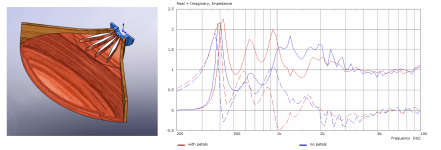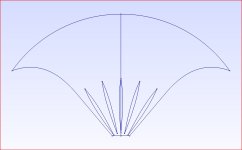That rendering comes from a solid model, the fins are not shown as it makes it hard to see the horn shape when they are rendered too.Hi @fluid, did you ever get around to making the full 3D solid model of the V2 horn?
Is the rendering below of the V2 horn? No fins?
But they are there in the simulation. The fins are more difficult to construct than those in the A290 as they are thinner at one end. Some form of 3D printing or CNC might be needed to get them just right, but a determined DIY'er with a jig could no doubt do it too 🙂
@docali and I are in discussion about releasing the design on his website. I would have liked to make one and verify it myself first, but the time scale for that keeps on extending.I have been tempted to order a pair of Yuichi A290 horns for a while, but these would be even better 🙂
The ES-290 is not a Constant Directivity Horn, it's not the same familly of horn.
A horn with fins as it's own way to radiate energy thanks to fins, where on a regular horn energy in +/-15° is very concentrated close to the 0°, on a horn with fins it's on +/-30°, it completely change the listening experience in room (due to side reflections).
Also, don't remove fins, they are here also for respect hypex surface law, if you remove it the behavior will be erratic, whatever the form of sides.
Maybe Joseph mimic the A290 sides and does it's own horn based of this but it's his own in-house horn, very different to an hypex with fins bi-radial.
If you don't want fins and CD behavior there is Ath4 OSSE or R-OSSE and HCD (hypex constant in H 75/70/60°) that are great.
Here the ES-290 polar :

A horn with fins as it's own way to radiate energy thanks to fins, where on a regular horn energy in +/-15° is very concentrated close to the 0°, on a horn with fins it's on +/-30°, it completely change the listening experience in room (due to side reflections).
Also, don't remove fins, they are here also for respect hypex surface law, if you remove it the behavior will be erratic, whatever the form of sides.
Maybe Joseph mimic the A290 sides and does it's own horn based of this but it's his own in-house horn, very different to an hypex with fins bi-radial.
If you don't want fins and CD behavior there is Ath4 OSSE or R-OSSE and HCD (hypex constant in H 75/70/60°) that are great.
Here the ES-290 polar :
Great info @NicoB, thanks!
So the ES290 is out. NicoB next gen bi radial horn, YuichiA290V2 or plain Yuichi A290 are the final contenders.
Choice will depend on availabilty of plans/step files, finding somone to cnc the horns and price. Plain Yuichi is.....well too plain when there are two exciting new kids on the block 🙂
So the ES290 is out. NicoB next gen bi radial horn, YuichiA290V2 or plain Yuichi A290 are the final contenders.
Choice will depend on availabilty of plans/step files, finding somone to cnc the horns and price. Plain Yuichi is.....well too plain when there are two exciting new kids on the block 🙂
This is a snapshot of my thinking with the throat section for a Yuichi inspired horn. It has since ditched the the first round-to-square section and keeps the 19mm radius all the way to the mouth.


Below is a system view of a full corner system. I plan on placing one more bass cabinet flipped upside down on top of this stack since i have 4 GPA 416's for a full MTM stack.

I do enjoy the system that i have enough not to be in any hurry so this will not happen until next winter. 🙂
//Anders
Below is a system view of a full corner system. I plan on placing one more bass cabinet flipped upside down on top of this stack since i have 4 GPA 416's for a full MTM stack.
I do enjoy the system that i have enough not to be in any hurry so this will not happen until next winter. 🙂
//Anders
Hi Anders, can you please tell me more about your current system? I also have a pair of GPA 416-8B that I want to make enclosures for.I do enjoy the system that i have enough not to be in any hurry so this will not happen until next winter. 🙂
Specifically, what size enclosures do you have for the 416's and are they vented?
Look a lot like reinterpretation of the RCA LC-9A to me !This is a snapshot of my thinking with the throat section for a Yuichi inspired horn. It has since ditched the the first round-to-square section and keeps the 19mm radius all the way to the mouth. View attachment 1153028View attachment 1153029
Below is a system view of a full corner system. I plan on placing one more bass cabinet flipped upside down on top of this stack since i have 4 GPA 416's for a full MTM stack.
View attachment 1153030
I do enjoy the system that i have enough not to be in any hurry so this will not happen until next winter. 🙂
//Anders
done. 🙂@docali and I are in discussion about releasing the design on his website...
https://sphericalhorns.net/2023/04/09/the-mk3b2-radial-fin-horn/
Excellent, thanks.
Looks remarkably similar to the Yamamoto F350 II BM... coincidence? Or convergent evolution?
Nice horns! I was only aware of the F280 which is very cost intensive. When you design a radial fin horn with pure exponential or hyperbolic loading and start with wide opening angles then all possible variations will look to some degree what you call similar. You could ask DonVK or fluid that my horn was simply coming out of my calculator and the adjustable parameters were optimized to give optimal BEM results. But if I look at the F280 or Yuichi or TH4001 they all have a suboptimal fin arrangement.
Certainly all @docali horn expansions are analytically created from his calculators and this is just one that I really liked out of a significant number (enough that I don't remember how many) of alternative variations. If I was to put all the CAD renders in succession many of them would be be hard to tell apart by looking, but they all simulate differently.You could ask DonVK or fluid that my horn was simply coming out of my calculator and the adjustable parameters were optimized to give optimal BEM results.
Before @docali got the hang of python programming in Fusion360, all the step files for simulation were made by me from his coordinates. The only attempt to copy an original design was the A-290 experiments this thread was about.
Oh how I missed this thread.
I have modeled several years ago both TH-4001 (with and without petals/fins to see to effect) and TH-4003 horn.
Here is several videos (actually, the videos were hidden for public access but now I made the videos public) for comaprision with other horns in this thread.
TAD TH-4001 SPL without petals/fins
TAD TH-4001 SPL with petals/fins
TAD TH-4003 SPL
Maybe we should consider combining these results for analysis ?
I have modeled several years ago both TH-4001 (with and without petals/fins to see to effect) and TH-4003 horn.
Here is several videos (actually, the videos were hidden for public access but now I made the videos public) for comaprision with other horns in this thread.
TAD TH-4001 SPL without petals/fins
TAD TH-4001 SPL with petals/fins
TAD TH-4003 SPL
Maybe we should consider combining these results for analysis ?
Attachments
Do you mean to compare the simulations of the A290 to TH4001? If so I can dig up and send you some VACS files.Maybe we should consider combining these results for analysis ?
It was your posting of the TH4001 Radiation impedance plot in mabat's thread that helped me realize I couldn't have been too far away in my own effort.
I did find an early sim result of the A290 without fins but that is the only one where I left the fins out, all the better models had the fins in.
Yes, you can send me results in VACS. Or you can send a step file of some version of the Yuichi horn, I will prepare two models with the same size fine mesh (I have access to a powerfull server so I can prepare very fine mesh), the same excitation conditions etc., so that the horn can be correctly compared. I've always wondered how different these horns are !Do you mean to compare the simulations of the A290 to TH4001? If so I can dig up and send you some VACS files.
It was your posting of the TH4001 Radiation impedance plot in mabat's thread that helped me realize I couldn't have been too far away in my own effort.
I did find an early sim result of the A290 without fins but that is the only one where I left the fins out, all the better models had the fins in.
I've attached a step file of V2 surface version seen in the first post you should then be able to keep the exterior of the horn and any adapter more similar. If you want something different let me know and I see if I can find it. Just keep in mind that this version simulates slightly better than one made from the values listed in the A290 line drawing.Or you can send a step file of some version of the Yuichi horn
Attachments
Were these simulated with adapter? If so, your adapter is not optimal.Oh how I missed this thread.
I have modeled several years ago both TH-4001 (with and without petals/fins to see to effect) and TH-4003 horn.
Here is several videos (actually, the videos were hidden for public access but now I made the videos public) for comaprision with other horns in this thread.
TAD TH-4001 SPL without petals/fins
TAD TH-4001 SPL with petals/fins
TAD TH-4003 SPL
Maybe we should consider combining these results for analysis ?
I largely prefer to see the radiation polar how VACS is presenting them rather than looking at the fields. Could you provide this?
Well, Yuichi A290v1 model is prepared ! hmax = 7mm mesh is used. The model took ~210 GB of RAM ! It's a pity that ABEC3/ Akabak can't work correctly with more than 64 cores because Windows splits the cores into smaller groups to enhance а system performance, but ABEC3/ Akabak sees only one processor group and ignore other cores. Therefore, it is necessary to disable some of the core/threads so that their number does not exceed 64.I've attached a step file of V2 surface version seen in the first post you should then be able to keep the exterior of the horn and any adapter more similar. If you want something different let me know and I see if I can find it. Just keep in mind that this version simulates slightly better than one made from the values listed in the A290 line drawing.
Last edited:
- Home
- Loudspeakers
- Multi-Way
- Yuichi A-290 CAD files, modifications and BEM simulation results


